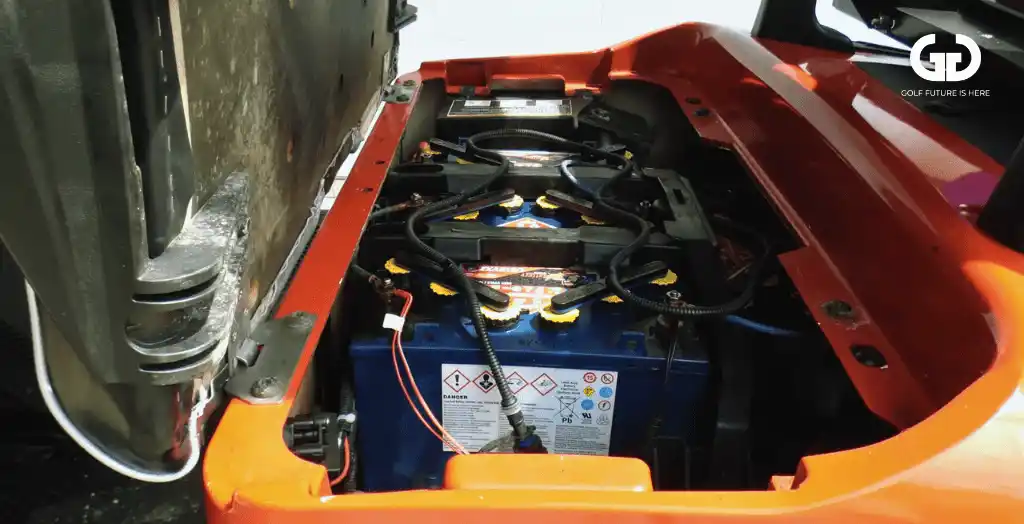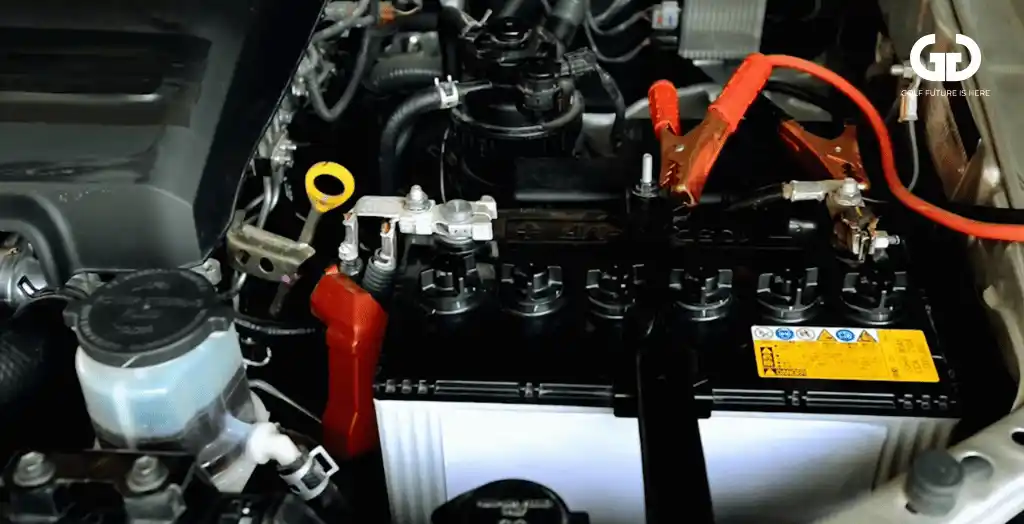Are you wondering why your trusty golf cart is now struggling to take you from point A to point Z?
Perhaps you’ve noticed more frequent trips to the charging station or realized that your cart only covers a fraction of the distance it used to. These could be indicators that your golf cart batteries are deteriorating.
Fear not – a dying battery is a common occurrence. In this article, we will delve into the expected lifespan of golf cart batteries, considering various types, and pinpoint the unmistakable cues that indicate it’s time for a replacement.
Most notably, we’ll cover the cost aspect and provide valuable insights into battery maintenance to steer clear of similar issues down the road.
Key Takeaways
- Your golf cart battery’s lifespan depends upon various factors like battery quality, maintenance frequency, charging habits, and even temperature conditions.
- Most of the batteries tend to last 6-10 years, if they receive regular maintenance.
How Long Do Golf Cart Batteries Last?
To put it broadly, a golf cart battery’s lifespan is highly dependent on various variables. These include battery quality and brand, maintenance frequency, charging habits, and even temperature conditions.
Additionally, how often you use your golf cart plays a significant role; whether you’re a weekend golfer or a daily cruiser can have a big impact on its battery life.
Out of the variables listed, the battery you choose makes a substantial difference. This choice can cause the battery’s lifespan to vary from a couple of years up to 20 (given proper maintenance, of course!).
So, which battery should you opt for?
Lifespan Of Different Types Of Golf Cart Batteries
In the realm of golf cart batteries, there’s a diverse selection to choose from, each with its own set of pros and cons.

Remember, your choice isn’t just about singling out the “best” type; it’s about finding the right match for your golfing style, preferences, and budget.
Lead-Acid Golf Cart Batteries
The Lead-Acid battery is what would be popularly considered the blueprint of golf cart batteries. They’re among the most affordable batteries and have been in the game for decades.
However, they do demand regular upkeep, including water refilling and ventilation. Yet, if you’re attentive to all of this, they can offer reliable power and a decent lifespan.
Absorbed Glass Mat (AGM) Golf Cart Batteries
On the flip side, AGM batteries are spill-proof and require minimal maintenance. They have absorbable electrolyte and fiberglass plates, which, in simpler terms, translates to a faster charge time in comparison to their Lead-Acid counterparts.
The downside? They do come with a slightly steeper price tag.
Gel Lead-Acid Golf Cart Batteries
Gel batteries offer a good middle ground; they’re robust, vibration-resistant, and spill-proof. No more fussing over water levels.
However, their cost is slightly higher, and they tend to struggle in extreme temperatures. They may also require specific charging needs to avoid overcharging.
Lithium-Ion Golf Cart Batteries
Lithium-ion batteries bring a lightweight and high-energy-density solution to the course. They deliver consistent power and extended life compared to traditional choices.
With speedy charging capabilities and low upkeep demands, they’re the cream of the crop. Yet, the initial investment can be significant, and specialized chargers might be necessary.
Check Out: How To Drive A Golf Cart: Step-By-Step Guide For Beginners
5 Signs That Your Golf Cart Battery Requires Replacement
All batteries will eventually show signs of wear. If your battery displays any of the five symptoms listed below, it’s time for a replacement:
1. Slow Charging Times
Charging times can vary based on the battery and charger you use. However, suppose you notice that your battery takes considerably longer to charge than it initially did. In that case, it strongly indicates internal wear and tear, signaling the need for a replacement.
2. Poor Acceleration
If you’re experiencing sluggish starts and weak acceleration, this points toward your battery losing its ability to generate sufficient energy.
3. Shorter Distances Travelled
If you’ve noticed a reduction in the distance your cart can cover, it’s a clear indicator that the battery’s energy storage is depleting.
4. Leaks
Batteries are never supposed to leak. Corrosive leaks are telltale signs of internal breakdowns or damage to the battery’s casing. Not only do leaks impact efficiency, but they can also pose safety hazards.
5. Visible Battery Damage
Cracks, bulges, or any observable structural damage on the battery hint at internal issues that affect both performance and safety.
TIP: If you’re still unsure whether your battery needs to be replaced or not, we recommend using a golf cart battery tester to help ease your worries.
By connecting it to the battery terminals, the tester assesses factors like voltage, charge capacity, and overall condition.
Before you start testing, however, you should charge up your batteries as you normally would.
How Often Do You Need To Replace Golf Cart Batteries?
Golf cart batteries tend to last 6-10 years, provided they receive regular maintenance. However, this timeline can shrink, especially if multiple people use the cart daily.

But remember, keep an eye out for the signs listed above. If your battery exhibits these symptoms earlier than its expected lifespan, it’s your cue to introduce a fresh battery to keep your golf cart rolling smoothly.
How Much Does It Cost To Replace Golf Cart Batteries?
You can expect to spend anywhere from a few hundred to over a thousand pounds when replacing your golf cart battery. The cost range will vary depending on what battery you choose.
Lead-acid batteries are usually the most budget-friendly option, with prices ranging from approximately £75 to £150 per battery. A full set of lead-acid batteries for a golf cart can cost around £300 to £600.
Lithium-ion batteries are considered the premium choice, with prices ranging from around £800 to £1,000 per battery and upwards of £1,500 or more. A complete set of lithium-ion batteries might cost between £3,200 to £6,000 or even more.
Golf Cart Battery Maintenance
1. Charge Properly
Don’t underestimate the importance of a proper charging routine. Optimal charging takes 8 to 10 hours; once fully charged, unplug promptly to prevent damage. Overcharging can harm the battery’s cells and lead to dryness.
2. Maintain Fluid Levels
Check water levels regularly and keep them topped up. Remember, hydrated batteries are happy batteries.
3. Don’t Let Batteries Die
Balance is key – avoid overcharging while also preventing batteries from dropping below 20% charge. Keeping this balance will extend the battery’s life.
4. Store Carts in a Warm Place
Cold temperatures can significantly reduce the efficiency of the batteries. When storing your golf cart, tuck it away in a cozy spot, especially during colder months.
5. Minimise Strain on the Battery
Be mindful of the load you place on your cart; assess its capacity for people and baggage. Lightening the load means a longer-lasting battery.
6. Inspect Batteries Regularly
Give your batteries a once-over now and then. Look for any signs of wear, loose connections, or corrosion. And for quick checks, rely on a golf cart battery tester – a quick yet effective tool.
7. Trickle Charge the Batteries
Show your batteries some TLC with trickle charging. This slow and steady charging method helps maintain their health during periods of inactivity.
Conclusion
If you follow our maintenance tips and remain attentive to the subtle signs of battery wear, you’re set to prolong your golf cart’s lifespan and (hopefully) steer clear of unfortunate breakdowns on the golf course!
Moreover, you’re now able to differentiate between each battery type, enabling you to make an informed choice on which one is perfect for you.
And remember, using a golf cart battery tester regularly is like giving your battery a health checkup. So, don’t hesitate to keep it as a handy tool in your kit.
FAQs
How far can a golf cart go on a full charge?
With a fully charged battery, your golf cart should cover a minimum distance of 15-30 miles, and some higher-end models can even travel 50 miles or more on a single charge.
How long do golf cart batteries last without charging?
Golf carts can typically sit between 2-3 weeks without charging, but it’s recommended to recharge them every 15 days to maintain battery health.





0 Comments